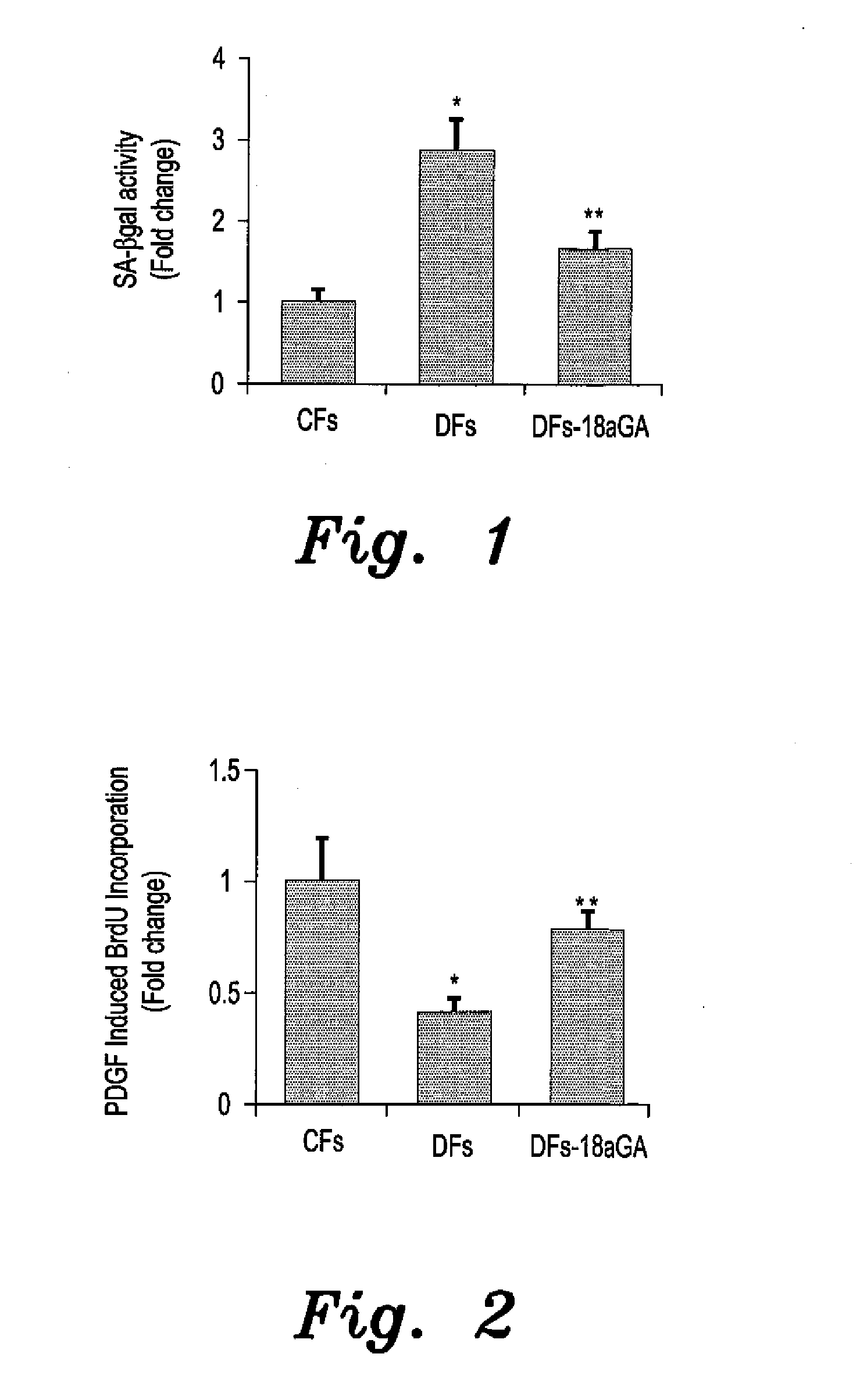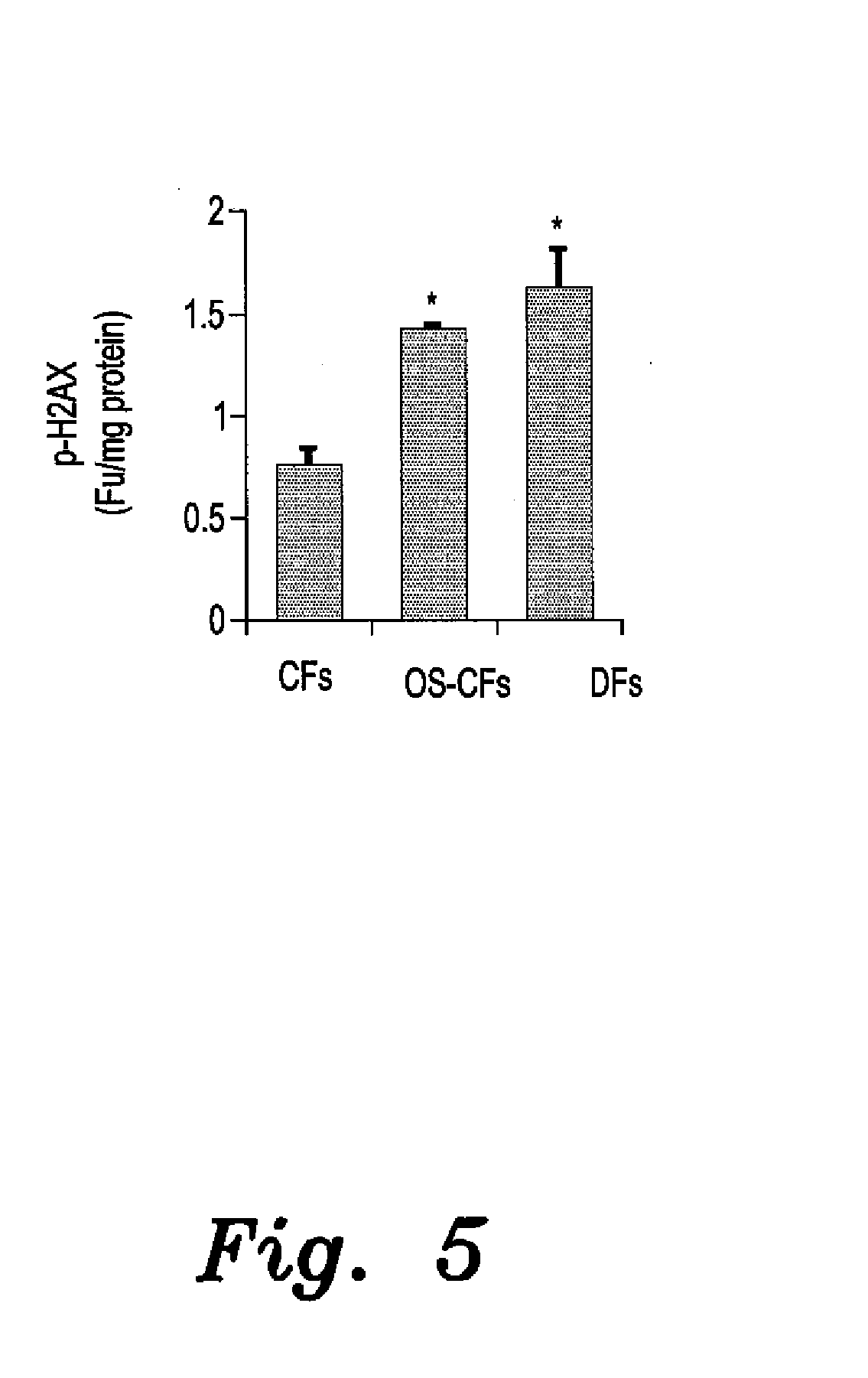Method of treating delayed healing of a wound associated with diabetes
a diabetes and wound technology, applied in the field of wound treatment, can solve the problems of affecting the healing process of wounds, affecting the regeneration of injured tissue, and none of these therapies, however, are completely effective, so as to promote the healing of delayed wounds, prevent and/or reverse premature cellular senescence, and promote wound healing.
- Summary
- Abstract
- Description
- Claims
- Application Information
AI Technical Summary
Benefits of technology
Problems solved by technology
Method used
Image
Examples
example 1
Senescence-Like Features and a Reduction in the Maintenance of Cellular Redox Balance in DFs and OD-CFs
[0083]Control (CFs, n=3), diabetic (DFs, n=4), and oxidatively stressed control fibroblasts (OS-CFs, i.e., fibroblasts that were exposed to hydrogen peroxide, 150 μM for three passages; n=4) were assessed for the presence of key biomarkers of cellular senescence. SA-β-gal activity was assessed by either staining cells with a chromogenic X-gal-based cocktail solution and visualizing the blue coloration of the cytoplasm by light microscopy or by incubating cellular protein extracts with MUG fluorogenic substrate and determining the rate of conversion to the fluorescent 4-MU product with a fluorometer. pH2AX contents were either visualized by immunofluorescence staining assay using Texas Red-tagged goat anti-rabbit IgG as the secondary antibody, or quantified by a DNA damage assay kit. Cells were seeded (N0) in DMEM supplemented with 10% FCS and were harvested at confluence (Nf). The ...
example 2
DFs and OS-CFs Exhibited a Significant Increase in Caveolin-1 Expression and Attenuation in Growth Factor Actions
[0085]Control (n=3), diabetic (n=4), and oxidatively stressed control fibroblasts (e.g., control fibroblasts exposed to hydrogen peroxide, 150 μM for three passages; n=4) were used to assess caveolin-1 expression and the actions of growth factors. Caveolin-1 protein expression and PDGF-induced phosphorylation of Akt (20 min) and ERK (10 min) in 24-hr serum starved fibroblasts were determined using a Western-blotting-based technique. A proliferation index encompassing BrdU incorporation into DNA and cell cycle progression was evaluated in response to various growth factors (e.g., IGF, 50 ng; PDGF, 1 nM; EGF, 100 ng) in 24-hr serum starved fibroblast. An in vitro wound-healing model conducted by scratching starved confluent cultured fibroblasts with a pipette tip was used to monitor the impact of PDGF on cell migration. Most of the assays were performed in triplicate, and t...
example 3
Effects of Caveolin-1 Overexpression and Deficiency on Cellular Senescence and Key Fibroblast Functions Essential for Wound Healing
[0086]CFs were transfected with caveolin-1-pCMV(pCMV-Cav-1) or its vector control (pCMV-GRP), whereas DFs were rendered caveolin-1 deficient (Cav-1 siRNA) using siRNA-based technique. Transfection efficiency in both cases was confirmed using Taq-Man real-time PCR and Western blotting. After culturing for 48 hrs, cells were assessed in terms of senescence biomarkers, as in the case of SA-β-gal activity (fluorescence-based assay kit), pH2AX contents (fluorescence-based assay kit), and the protein expression of p53 (western blotting) and p21 (Western blotting) using fluorescence-based assay kits or Western blotting. Similarly, pCMV-Cav-1 and Cav-1 siRNA were also evaluated in the context of PDGF actions on p-Akt levels and key fibroblasts functions essential for wound healing, including BrdU incorporation into DNA (spectrophotometer-based assay kit) and cel...
PUM
| Property | Measurement | Unit |
|---|---|---|
| optical density | aaaaa | aaaaa |
| pH | aaaaa | aaaaa |
| pH | aaaaa | aaaaa |
Abstract
Description
Claims
Application Information
 Login to View More
Login to View More - R&D
- Intellectual Property
- Life Sciences
- Materials
- Tech Scout
- Unparalleled Data Quality
- Higher Quality Content
- 60% Fewer Hallucinations
Browse by: Latest US Patents, China's latest patents, Technical Efficacy Thesaurus, Application Domain, Technology Topic, Popular Technical Reports.
© 2025 PatSnap. All rights reserved.Legal|Privacy policy|Modern Slavery Act Transparency Statement|Sitemap|About US| Contact US: help@patsnap.com



